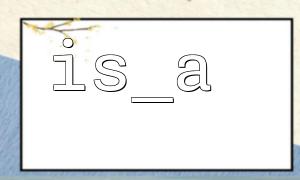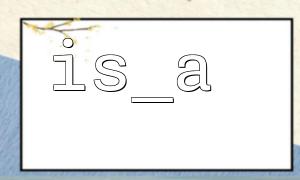In PHP's exception handling mechanism, try...catch is a structure that developers use frequently. Normally, we use multiple catch blocks to capture different types of exceptions. However, if you want to handle multiple exception types in one catch block, or even dynamically determine the exception type at runtime and apply different handling logic, you can make use of the is_a() function to achieve a more flexible branching approach.
The is_a() function is used to determine whether an object is an instance of a specific class or if it inherits from that class. Its basic syntax is as follows:
bool is_a ( object|string $object_or_class , string $class , bool $allow_string = false )
$object_or_class: The object or class name to be checked.
$class: The class name to check against.
$allow_string: If set to true, it allows the first argument to be a string (class name).
In exception handling, we typically set the first argument to the caught exception object, and the second argument is the name of the exception class to check.
Let's assume we have the following custom exception classes:
class DatabaseException extends Exception {}
class FileNotFoundException extends Exception {}
class PermissionException extends Exception {}
Then, we throw different exceptions in the code:
function riskyOperation($type) {
switch ($type) {
case 'db':
throw new DatabaseException("Database error");
case 'file':
throw new FileNotFoundException("File not found");
case 'permission':
throw new PermissionException("Permission denied");
default:
throw new Exception("Unknown error");
}
}
Now, let's see how to use is_a() to implement a unified catch block to handle different types of exceptions:
try {
riskyOperation('db'); // You can change this to 'file', 'permission', or others
} catch (Exception $e) {
if (is_a($e, 'DatabaseException')) {
echo "Database error handling logic\n";
// Log to the database error log: <code>https://m66.net/log/dbAlthough PHP supports multiple catch blocks, using is_a() has the following advantages:
Compact code: Handle all exceptions in one catch block, reducing duplicate code.
Dynamic scalability: Exception types can be determined dynamically through configurations or data, rather than hardcoded in the code.
Suitable for logging/recording systems: Allows unified log handling in one logical block, and then distinguishes by exception type.
You can further enhance flexibility by using a mapping table:
$handlers = [
'DatabaseException' => function($e) {
echo "Handling database exception: " . $e->getMessage() . "\n";
},
'FileNotFoundException' => function($e) {
echo "Handling file exception: " . $e->getMessage() . "\n";
},
'PermissionException' => function($e) {
echo "Handling permission exception: " . $e->getMessage() . "\n";
},
];
<p>try {<br>
riskyOperation('file');<br>
} catch (Exception $e) {<br>
foreach ($handlers as $class => $handler) {<br>
if (is_a($e, $class)) {<br>
$handler($e);<br>
exit;<br>
}<br>
}<br>
echo "Default exception handling: " . $e->getMessage() . "\n";<br>
}<br>
This approach allows dynamic adjustment of handling logic based on actual needs, making it suitable for more scenarios, such as plugin architectures, modular frameworks, and more.
is_a() is a simple but powerful tool. Using it in exception handling can break through the limitations of traditional catch blocks, enabling unified and flexible branching logic. Whether improving code maintainability in large projects or quickly debugging error types in smaller applications, it provides great convenience. Mastering it will make your exception handling logic stronger and more elegant.














